Paradox Sea Trials
By Glen
Maxwell
It was my view that in order to
really get to know Zoë and learn
her quirks, I would need to spend a few days, at the very least,
just sailing and living aboard her. I decided to sail from Cedar
Key on the Gulf of Mexico south to my brother Gary’s home
in Port Richey, where if need arose, I could effect repairs or
modifications at his dock. From there, I would continue to Ancolote
Key and then to Honeymoon Island just north of Clearwater. Rather
then striking straight out across the gulf the 57 nautical miles
to Port Richey, my track would lead me along the coastline and
afford the opportunity to explore grounds new to me.
I arrived in Cedar key on December
3rd, accompanied by my wife Nancy and my mom, just before noon
at low tide and a dying breeze. By the time Zoë
was in the water and I had her sail up, there was no wind at all.
After good byes all around, I shipped the yuloh and headed out
to the channel where a light breeze left a wind line. It was 12:40,
Dec. 3rd 2001.
Mr. Yuloh and I were still not
great friends at this juncture, and after about twenty minuets
of trying to get it to stay on it’s bronze ball, I decided
I would either have to come up with a way to keep it there or
replace it with a sculling notch upon my return home. Shortly,
I hit on the idea of securing a line to the base of the pivot
in such a way as to leave a long tail on both sides. The yuloh
was then mounted, and the line tied around its shaft such that
it was captive to the ball but allowed to move all around. Finally,
off we went sculling down channel.
Off and on for the next hour the
breeze would fill in from behind only to die away after a while,
and I would alternately scull and sail. The good news was that
in these zephyrs of about 5 mph Zoë
would accelerate rapidly to between 2.5 and 3kts as reported by
the GPS.
While I was launching Zoë,
two men were in the process of loading their sea kayaks with camping
gear, and it wasn’t long before I could see them paddling
past and along the shoreline. I elected to get away from the shore
a little in hopes of finding some wind, and about 2:30 the breeze
filled in from behind and held. The wind, though light, was sufficient
to get Zoë up to a whopping 4kts,
the fastest she had sailed yet. At this speed she was only ¾
knot away from her calculated hull speed. The wind could not have
been more then 8kts at this time, and the sea was very smooth.
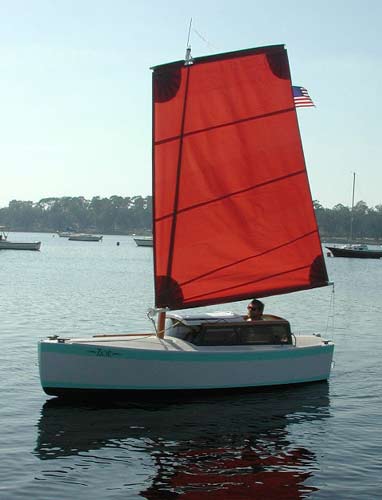
By 3:30 I had picked out a likely
anchorage in the mouth of Deep Creek and set my course for it.
I caught sight of the sea kayakers, far back and along the shore;
I had regained the lead. Around 4:30, the wind veered into the
northeast and forced me to come up hard on the wind for a forty-five
minute beat to an anchorage in the west pass to Deep Creek. While
beating, the kayakers caught up to me and headed into the west
pass where there appeared to be a small hammock suitable for camping.
I elected to give them some privacy and altered course for the
east pass.
After getting my anchor down and
setting about the evening chores, I noted the kayakers underway
behind me paddling to the east. It was now 5:30, and the sun was
setting. With only about 30 minutes of daylight left and no camping
areas in sight their plight was grim indeed and I could only imagine
how they would have to search for a suitable campsite in the dark.
I, on the other hand, reveled in the fact that my habitat was
secured to the bottom and I needed only prepare my evening meal
and turn down my bed, a warm and dry place to sleep having previously
been assured.
For a mattress, I had on board
one of the inflatable type of twin size, cheaply procured from
Wal-Mart prior to departure. I found that it was easily inflated
with a 12 volt pump designed for the purpose, but that it took
all of seven minutes to accomplish the task. Once the pump was
removed and the mattress dropped into place, it was a pain to
pull it up and add more air should it be needed. The fit, however,
was perfect for the interior of Zoë
and once in place and properly inflated, it was grand indeed to
lay under the open hatch, wrapped in my sleeping bag, and watch
the stars dance through the window of the hatch frame.
5:45 the morning of 4 Dec. found
me up and about, and while it took seven minutes to inflate my
mattress, it deflates in less then one and is easily folded in
thirds and rolled up to be stowed in the “forward stateroom”
along with my pillow and sleeping bag, thus clearing the main
cabin in as little as 5 minutes, less if I don’t take the
time to bag the sleeping bag. All the while my coffee has been
brewing on the little gimbaled stove which resides in the port
aft locker. When brewed, the coffee is transferred into a thermos
and the pot cleaned to receive more water, which is brought to
a boil and poured into a large mouth thermos containing Ramen
or instant rice. Once capped a hot lunch is assured with no cooking
hassles. Before I was able to put my lunch water on, I noticed
that the tide was ebbing at such a rate as to leave me high and
dry if I did not get myself into deeper water quickly. I darted
forward, weighed anchor and sculled/drifted out the mouth of Deep
Creek, where I once again anchored until I was ready to leave.
I finished my pre-underway chores
while enjoying a first cup of coffee and listening to a pair of
loons paddling nearby. I was not aware until this time that loons
frequented this area on their migrations.
By 7:10 I was underway, having
stowed the ground tackle in the aft starboard locker. You may
wonder what it is like walking around on the deck of such a small
boat. Well, it is initially like walking around on the gunwale
of a canoe with the exception that, properly ballasted, the Paradox
stops short (about 8”) of putting her rail under. It takes
awhile to get your confidence up that she won’t get you
wet, but by the end of my trip, I was walking down her side deck
with a retrieved anchor, chain and rode in a canvas bag without
a worry; whereas at the beginning of the trip I was hunched over
the cabin gripping the mast for fear of a capsize as I went fore
and aft.
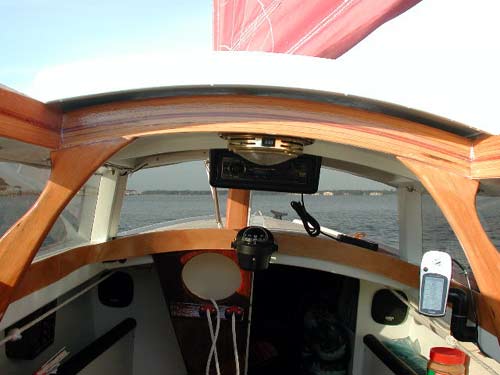
I left the anchorage in a 10kt
breeze from the NE that allowed me to broad reach on a course
that would take me out to sea about 5 miles - which I allowed
as enough of a clearance around the nuclear power plant at Crystal
River to be safe from their security zone should one be in place.
A 7:30 entry in my log records that we were doing speeds of 4.8
to 5kts, and as the winds increased during the morning, our speed
did likewise. By midmorning in a 12 to 15kt wind the GPS indicated
a sustained speed of 5.5kts with bursts to 5.9. Later, I was to
note that the max speed recorded by the GPS was 6.3, but I never
actually saw it that high.
With the sea state up to
about three feet and occasionally rolling into our starboard stern
quarter, sending spray up to and over the hatch, I decided it
would be a good time to try out the below decks helm station.
Folding the seat into its stowed position, I arranged my seat
cushion, which has a built in back rest, to port, and closed the
hatch. It was simply delightful; here I was completely protected
from the elements, a cup of hot coffee in one hand and the tiller
line in the other as we boiled along at a steady 5.5kts. The only
thing I want to add is a port in the hatch, so that I can see
the sail in order to properly trim while steering from below.
I have left room between the end of the hatch and the solar panel
for this eventuality.
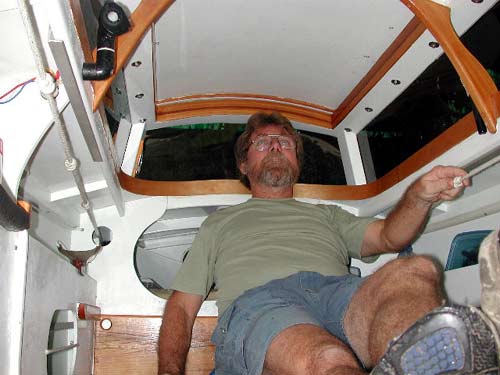
The helm, while very light, had
enough weather helm in it that I decided to play with getting
Zoë to steer herself. To this end,
I tied a short section of line to the aft bulkhead thru the tiller
line exit hole in such a way as to allow me to put a rolling hitch
around the tiller line with the other end. In this way, I could
add or subtract tension on the tiller line by sliding the rolling
hitch back and forth. After some fiddling, a degree of success
was attained, and I was allowed the freedom of a few minutes away
from the helm to attend to such matters as reading the chart and
fixing my position, pouring another cup of coffee, or later in
the evening, fixing myself a drink. The success was limited in
that any gust of wind would send her up to windward, and while
I was often able to bring her back by just a quick pull in the
weather direction, as often as not, I would be required to start
the fiddling all over. I deemed it unsatisfactory on a broad reach
to the extent that I will fit an Autohelm 800 from my spares locker
at home for the next trip, so that I will be allowed to read while
in transit. Later in the trip I had the opportunity to use the
same setup while beating to windward and found that Zoë
self-steered to windward very satisfactorily, as do most sailboats.

My log also records that at 9:20
the first fish of the trip was caught and landed. Of it’s
type, I am uncertain, but think it was a scorpion fish. At any
rate, it looked unsavory enough that I returned it to the sea,
four others were eventually caught during the trip and likewise
released. I will go on record that I am not a sport fisherman,
lacking the patience to sit and soak a worm so to speak, but I
do love a fresh fish dinner. To this end, my tackle box is very
rudimentary, consisting of a very heavy line - that some have
referred to as weed whacker line, with a heavy steel leader on
one end and a bungee cord on the other which I affix to one of
the stern cleats. I’m more often than not attending to more
pressing matters such as reading when a fish takes a liking to
my bait which is usually just a piece of white or red rag on a
suitable hook. I’m generally made aware that “I have
one on” when I look aft and see the fish skipping across
the surface having long since drowned in the case of a small/slow
one or a bow string tight bungee cord in the case of a big/fast
one. For this trip, I substituted a Johnson Silver Minnow for
bait, and light line and leader, which later would prove a mistake
as I approached my brother’s the following day. Another
“must have” for the truly indolent fisherman is a
squirt bottle filled with denatured alcohol. A fellow cruiser
in Venezuela introduced this item to me years ago. Once landed,
a fish will often as not want to make good his escape and even
if you should want this for him as well (as in the case of a barracuda),
you will probably want to retain your lure. Enter the alcohol;
a quick squirt down the trashing beast’s mouth and over
his gills will instantly transform him into a hunk of peaceful
flesh, allowing you to retrieve your lure and dispose of him in
the way of your choice. Lacking denatured alcohol any alcohol
will do, although a doctor friend has warned me that isopropyl
should not be used as it is not good for our systems, and many
are the times I have had to blow a mouthful of good rum down a
fish’s mouth for want of denatured alcohol. Such was to
be the case the following day as I approached my brother’s
canal. I landed a Spanish mackerel of about eight pounds. While
fumbling with the rum bottle and dangling the mackerel from the
leader, the fish succeeded in breaking the leader and making off
with my lure. This was especially painful as it would have been
a great dinner offering for that evening. Live and learn, no more
light tackle.
Later in the day, there
was some excitement while sailing through the channel leading
into the cross Florida barge canal. I was steering to go midway
between two spoil islands and traveling at around 5kts when I
saw waves breaking directly ahead of me, I might add that it is
very hard to see breaking waves from the back side. Realizing
it was a shallow spoil area, I quickly headed up and was able
to clear it, barely. Zoë almost
had her first high speed grounding, an item not on the sea trial
check list.
By 1:00 pm the winds had fallen
off, and we were off the Bird Keys and the St. Martin Keys. I
had hoped to stop here and do some exploring, but found the tide
down so far that it was dry out about a mile from the keys, so
I fell off and continued SE. A 2:00 pm log entry reports: “
for the last few hours we have been sailing over water so shallow
that you can occasionally hear the grass scraping on the bottom.
The water is very clear and it is amazing that we are still sailing
at 2.8 to 3.2kts. This is so much FUN!”
Around 5:00 pm I was able to get
an anchor down behind a very small key about a mile and a half
offshore amongst the Chassahowitzka Reefs. We had made good a
distance of a little more then 33 nautical miles, in first moderate
and then light airs, certainly a better showing then the previous
days 11.8 nautical miles. I could see Crawl Key to the south about
a half-mile away, but decided to stay put because I was afraid
if I went any farther I might not find any better anchorage, and
it might be worse. As it turned out, the next day the choice was
a good one. I had hoped to get out and stretch my legs, but the
tide was so high that there was nothing but saw grass and scrub
to walk around in. Having only about an hour of daylight left,
I decided to get dinner out of the way and then catch up on my
log (I record the day’s events on a micro recorder and then
transcribe into my logbook). After preparing a one-pot meal in
my pressure cooker, I wolfed it down, surprising myself at how
hungry I was. One of the great things about the Paradox design
is that when it comes time to do the dishes, one only needs to
lean over and the boat rolls down enough that you can wash up
in the sea water without the need to bring water aboard in a bucket.
If you do need to use a bucket, because of very shallow water
or if you are dried out, it is handy to stand at the back of the
hatch with the bucket on the after deck while you take care of
your chores.
Just as I finished my meal,
the wind veered enough so as to take away the protection once
offered by the small key, and a chop began developing. I went
forward and weighed anchor, returned aft and shipped the yuloh
and sculled my way into quieter waters and anchored anew. This
was accomplished without tying down the shaft, so the training
device was working. By this time, I was also much more comfortable
walking up and down the side deck.
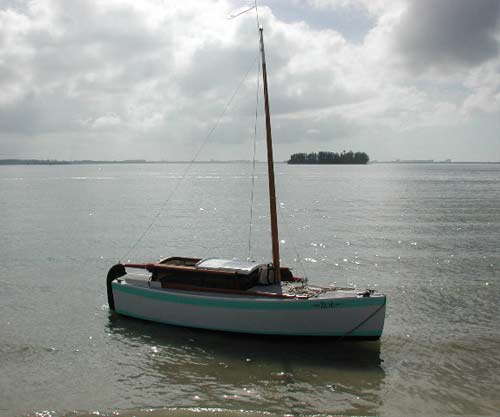
That night, as I lay upon
my poorly inflated mattress and contemplated the stars overhead,
I began to question the virtues of my bed. The air chambers were
long tubes like the ones popular for floating on in pools, and
as such, it was not as comfortable as it had been the previous
night when I was so tired that I had fallen asleep within minutes
of laying my head down. I considered how annoying it was to inflate
it while listening to the howling blower motor for an unseeingly
long seven minutes, only to find that after I had put the inflator
away, I would now need to get back up and add more air. Would
a good quality self-inflating camping pad be the answer? I would
have to wait until I got to Gary’s to get one. Other than
that, I dosed off feeling very fortunate to be micro-cruising
in such splendid comfort aboard a little vessel of my own building,
and one which was so well appointed thanks to the attention Matt
Layden had given her when he designed the Paradox.
The morning of the 5th found me
lounging in bed as the sun lit up the sky thru a light fog. A
pair of loons communed in the distance, and the sound of fish
breaking the surface drifted over the glass smooth water to where
I lay thinking of what the day would bring. The distance to Gary’s
channel entrance was approximately 22 miles, so there was no need
to hurry with breakfast and the morning chores. I reached up and
slid back the hatch and peered into what little sky broke thru
the low fog. Switching on the VHF weather channel, I was informed
that the day promised to be a nice one with winds forecast from
the northeast at 8 to 12kts veering into the east as the day wore
on.
After stowing my sleeping gear,
I put on a pot of coffee, fixed myself a light breakfast, prepared
a lunch of Ramen in my thermos, and made ready to get underway
by washing and stowing all lose gear. The anchor was aboard by
0735 and after raising sail, I settled on a port tack course that
would clear all hazards and take us to the entrance channel to
Gary’s house. What a wonderful morning sail we were having
as Zoë skipped along at 4.6 kts
over a smooth sea whose surface was broken every now and again
by startled mullet who happened to stray into our path. As we
passed Crawl Key, I could see that there was no better anchorage
then the one we enjoyed the previous evening, and it too was not
very interesting at close range. I was disappointed at the lack
of interesting keys for a shoal water sailor to explore along
this stretch of coast.
The morning wind was steady and
our point of sail sufficient that Zoë
would sail herself without the need for attention long enough
that I was allowed to read and watch the sea roll by. I streamed
the fishing tackle from the starboard stern cleat and settled
in with a copy of Steinbeck’s “Of Mice and Men”,
occasionally glancing at the compass or scanning the sea in all
directions to insure our own survival. This was the type of sailing
I loved.
About 10:30, I glanced at the
fishing line and noticed we had a fish on. It turned out to be
the large Spanish mackerel I mentioned earlier. After resetting
the tackle and streaming it once again, I went back to my “watch
keeping”.
12:40 found us off the entrance
to Gary’s house, but the tide was so far out that even Zoë
with her 9” draft could not get closer then about ½
mile. I dropped and stowed sail and attempted to scull and pole
my way in but was soon aground. No problem, I set out the anchor
and made up my bunk for a little nap while awaiting the tide.
What a rough life!
By 2:00 the tide was up enough
that I could start the scull to windward, and this I did, but
I first tied down the yuloh with the “training device”
knowing that I would be at it for a while. Along the way I passed
some gentlemen fishing from a pontoon boat. We hailed each other
and many kind words were spoken of Zoë;
I beamed with pride as we sculled on. It took a little over an
hour to cover the 1.6-mile trek up the channel to Gary’s
dock. As I rounded the corner of their channel, I found Gary and
his wife Sue waiting and waving, having been alerted to my arrival
by a cell phone call just before weighing anchor. It wasn’t
long before Zoë was tied to their
dock, and all was made secure. A glance at the GPS showed a distance
of 25.1 nautical miles made for the day.
I spent the 6th of Dec. tied up
to Gary’s dock, while I took care of some minor problems
which had developed. One problem was that the tang on the end
of the boom was not stiff enough and would bend inward and occasionally
bind while rolling the main up. This would cause the main sheet
to be furled around the sail and lock everything up. Of course
this would happen while I was looking forward, so by the time
I discovered the problem, I would have a mess on my hands and
have to hoist the main and untangle everything. Also, I found
that the sail was not as easy to furl as I had hoped because as
the main halyard was slacked, the sail would fall, making it difficult
to haul in the furling line. Everything seemed to work fine if
I supported the boom while furling. The only way to do this and
free up both hands to control the halyard and furling line was
to let the boom rest on the coach roof while furling. I felt a
topping lift would solve the problem, so I rigged a temporary
one to try on the remainder of the trip. At a craft store close
to Gary’s house, I acquired some leather scraps and used
them to make holsters for pens, pencils, flashlight and knife
by nailing the leather to appropriate places on the bulkheads
and uprights, thus ensuring they would fall easily to hand when
needed.
The 7th dawned clear with a light
offshore breeze, and after a cup of coffee with my host and hugs
all around, I walked down to Zoë
and cast off. A pull on the new topping lift, and the furled sail
came up ready to be hoisted. The Paradox is lug rigged, thereby
requiring the topping lift to lie on one side or the other of
the sail. I had rigged it to lie on the starboard side, and attention
was needed for the first few feet to insure the yard did not get
on the wrong side during rising. The sail went up without a problem,
and we were away at 08:30. The sail down the channel and into
the Gulf were uneventful and took only 15 minuets, having the
wind and current with me.
Once into the Gulf, I decided
to sail around and explore a few of the many stilt homes that
have been built about a quarter mile offshore. After picking out
an interesting looking one, I hardened up on the port tack and
Zoë and I sailed over for a closer
look. As we approached, I had fantasies of living out here in
the gulf on just such a home built up above the water. As I got
closer the attractiveness began to tarnish. The home, while in
good repair, seemed lonely and sad; the stench of seabird guano
grew more appalling with every foot we approached. When we were
actually downwind, the stench made my stomach churn. I quickly
jibed over onto the starboard tack and made haste to depart the
offensive area, so much for fantasies of stilt homes.
Once I had cleared the area enough
to jibe back over onto the port tack, I did so and set a course
for the northern end of Ancolote Key; the idea being to approach
from up wind and then fall off and sail down the coast as close
as I could get to do some exploring. In this fashion, should something
interesting ashore catch my eye, it would be a simple matter to
round up and beach Zoë.
With well over an hour to arrival,
I figured I might as well get out the fishing gear and try my
luck. In short order, I had a line over and had settled down for
a delightful morning sail. This was the first time that I had
been running free on the trip and, shortly it dawned on me that
we were not rolling. I had been concerned during the building
of Zoë that because there was no
boom vang she would have a tendency to roll her guts out when
off the wind. I was sailing along at 4.3 kts downwind with only
a very slight and by no means uncomfortable oscillation about
the roll axis. After thinking about it for a little while, I can
only surmise that the chine runners were acting as roll dampers,
or perhaps the balanced lug rig is not prone to inducing roll
off the wind. Whatever the case, it was a pleasant surprise and
endeared the little Paradox design to me even more.
By the time we reached the north
end of Ancolote Key, the wind had died to almost nothing, and
we ghosted along the Eastern Shore at about a knot and a half.
I did manage to catch another small scorpion fish and release
him. At this speed, the fishing line is more trouble than it is
worth, so I stowed it away.
Ahead of me, a steel cutter of
about 30 feet lay to anchor, and my track would take me down her
port side for a closer look. As I approached, a weather-beaten
old man appeared from the hatch and spoke of his overnight passage
from Pensacola. He was very proud of the fact that his old rusty
girl had averaged 5 kts for the passage and having just arrived,
was getting ready to retire to his berth for a well-earned sleep.
I bid him pleasant dreams and continued on my way.
My destination was an attractive
beach near the south end, and upon arrival I sailed Zoë
right up onto the beach. Taking my anchor bag in hand I stepped
overboard and waded ashore where I set the anchor and then walked
back and made the line fast to the bow cleat. An abandoned lighthouse
stands guard over this end of the key, and I gathered my camera
to go and have a look. I walked along the beach marveling at the
absence of people. It being a Saturday, I had anticipated a fleet
of boats and their crews enjoying the beautiful beaches here.
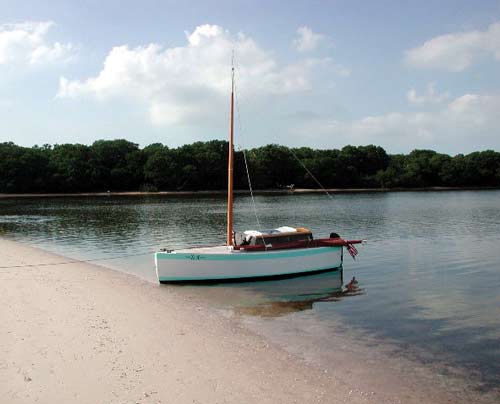
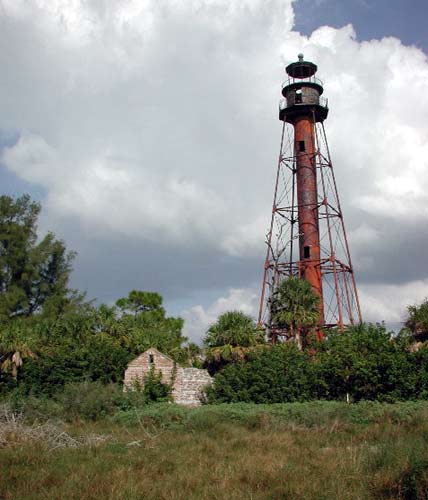
Once at the lighthouse, I climbed
to the top and surveyed the island. Zoë
lay peacefully at anchor to the west with her bow touching the
beach just as I had left her. Around the south end of the island,
a creek opened up and led into a beautiful and protected anchorage.
Across the sand spit guarding the anchorage, a clean white sandy
beach stretch for miles to the northwest end of the island. A
fishing boat of about 30 or 40 feet appeared shipwrecked up the
coast a half a mile or so. On the northeastern side another anchorage
surrounded by mangrove was accessible from the south and a character
type cabin cruiser lay to anchor there. I took a number of pictures
and then descended the long circular stairway as a young couple
made their way to the top.
Back at Zoë,
I elected to shove off and sail around to the anchorage on the
westside. Within minutes, we were underway and after a pleasant
sail around the southern tip, I was able to test Zoë's
short tacking ability as we entered the mouth of the tidal creek.
The starboard tack was favored, and we were able to sail almost
to the shoreline. After about six tacks in which Zoë
never failed to come about, we found ourselves in a bay of sorts
and sailed to within a few feet of the western shore and anchored
for the evening.
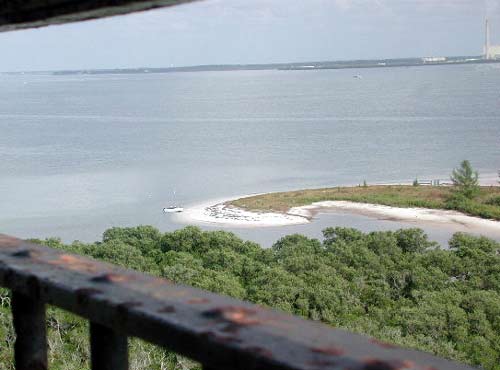
Jumping overboard into ankle deep
water, I made my way across the sand spit to the beach and took
a stroll toward the wreck seen from the lighthouse. I hadn’t
gone far when a light rain began to fall, so I turned and headed
back. Across the bay from me a man was walking northward; he waved
in my direction, and I waved back and continued on to Zoë
where I boarded and closed the hatch to escape the rain. After
fixing myself a drink, I settled down with a book and was thus
occupied when the afore mentioned stranger showed up alongside.
I opened the hatch and greeted him. He introduced himself as Mark
van Abbema, a fellow sharpie enthusiast. I climbed
out of Zoë and closed the hatch
to keep the rain out and we chatted about the relative merits
of sharpies all the while getting soaked to the bone. As it turned
out, Mark was the owner of the cabin cruiser, Heart
of Gold II, anchored in the mangrove bay on
the east side of the island. The previous year I had been anchored
in Ft. Myers Beach where a very attractive small cabin cruiser
by the name of Heart of Gold was also
anchored. As it turned out, she had been his and was sold to build
Heart of Gold II. Mark invited me to
come over the next day for a visit. After promising to do just
that, we parted company. As he strolled back in the rain, I climbed
back aboard and shed my wet clothes for dry. I looked forward
the next day’s visit and inspection of Mark’s new
boat.
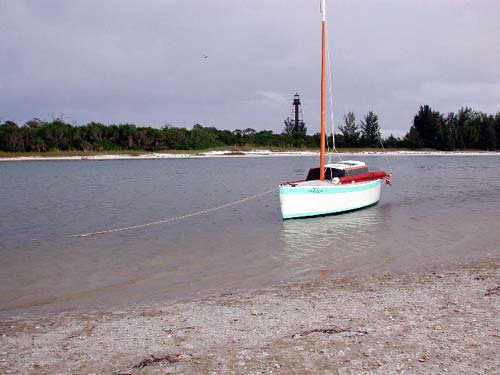
I awoke the morning of the 8th
to find Zoë high and dry, the tide
having gone out some hours before. A fresh pot of coffee was put
on, and by the time it was ready all aboard was ship shape and
ready to go sailing when the tide returned. I took the opportunity
to do some beach combing and walked about halfway up the beach
past the wreck, which turned out to be a fiberglass inboard probably
washed up during a storm. The beach here is a delight to walk
on, clean white sand and fairly firm under foot. I marveled at
the lack of trash so often found on Florida beaches. It seemed
I had the whole of Ancolote Key to myself, the only visible signs
of humanity were the fishing boats out on the Gulf, and they were
far enough out that their engines could not be heard.
Arriving back at Zoë,
I found the tide not quite high enough to float her, so I set
about fixing myself a big southern breakfast of bacon, eggs and
grits. By the time the dishes were done we were free of the bottom.
Sail was set, and we ghosted out
of the bay at 10:10 am. It took a little over an hour in the light
breeze to sail back around the southern tip and up into the mangrove
bay where Heart of Gold II lay anchored.
As I approached, Mark, who had been up on the north end of the
island exploring, returned and bid me welcome. Shortly, Zoë
was hanging off the stern along side Heart of Gold
II’s tender, which I might add was almost
as long as she.
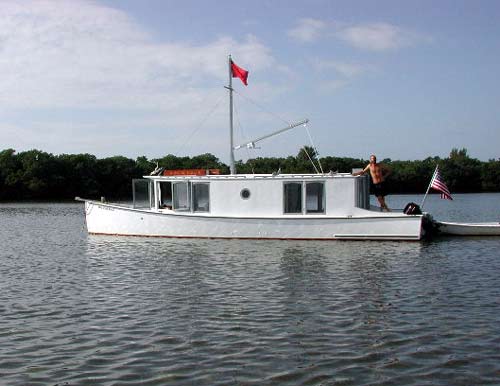
The first thing one notices when
stepping into the saloon of Heart of Gold II
is how light and airy she is. While only having a beam of 8 feet
she has a little over 6 and a half ft of headroom and large windows
that light up a very comfortable interior. After a week aboard
Zoë, I felt as though I was in
a palace. There is no bilge, so you stand on the inside of the
hull, which is varnished tongue and groove fir. There is a long
desk down the port side and a couch that converts to a double
over seven feet long on the starboard side. Going forward, there
is a head and a pantry port and starboard and then the pilothouse.
Mark plans on marketing building
drawings for her, so keep an eye out if you’re
interested in a very comfortable shoal draft motorboat with a
lot of character.
The remainder of the morning and
early afternoon was spent visiting with Mark and listening to
tails of his adventures after the launch and subsequent trip down
the Missouri and Mississippi Rivers and across the Gulf of Mexico
to Ancolote Key. It would have been easy to while away a few days
exploring and chatting with Mark, but my time was running short,
so I bid farewell and following seas, slipped Zoë’s
tether and set sail in a dying breeze for the eastern end of Honeymoon
Island.
It was all I could do to make it
to a small spoil Island about two miles north of my destination
before dark, but once there I was able to find shelter from the
wake of motorboat traffic behind it. After getting the anchor
down and dinner out of the way, I settled down for a little reading
before retiring. It wasn’t long before the gentle motion
and night sounds lulled me to sleep.
The 9th dawned clear with the barest
of breezes stirring the pine needles on the casuarinas trees ashore.
I had arranged to meet Nancy just after noon, so I had the whole
morning to make it to the haulout area. A leisurely cup of coffee
was followed by the completion of my morning chores, and Zoë
was ready to go.
What wind there was came
from the southeast, and a slight current ran against us making
the final leg of this trip a claw to weather against a foul tide.
I took one long tack toward the northwestern end of Honeymoon
Island causeway in hopes of finding shallow water and less current
as well as to explore the area. It turned out to be a good choice;
there was little current, and the area was beautiful and full
of wildlife. Tacking over onto starboard, I made my way east along
the causeway toward the bridge, which I would have to transit.
I positioned myself as far to weather of the center span as possible
and tacked over. The current was at its strongest here, and two
more tacks were required to get under the bridge where all wind
was lost. The yuloh practice really paid off here, as I was able
to quickly put it in motion, and sculling as hard as I could,
managed to stem the current and get through the bridge, where
I was able to fall off enough to gather way under sail again.
I picked out a place on
the beach that looked to be good for a haulout and nosed Zoë
ashore, ending my first real cruise with her. As I prepared her
for hauling out, I reflected on my trip and the enjoyment it had
given me. There is real wonder in building a boat from scratch
and seeing her floating before you after months of hard labor,
and it can only be eclipsed by the delight it serves you during
use. Oh yes, there are still things to do; a skylight must be
installed in the hatch, a chart table would sure be nice to keep
the chart off the deck, a permanent topping lift controlled from
below and let’s not forget that all important mattress.
Another real pain in the butt, literally, is the seat board. No
matter which cushion arrangement I tried, it was not long before
my rear end was complaining about the hardness of the seat. Problems
I put my thoughts to solving while I awaited my ride home.

|

